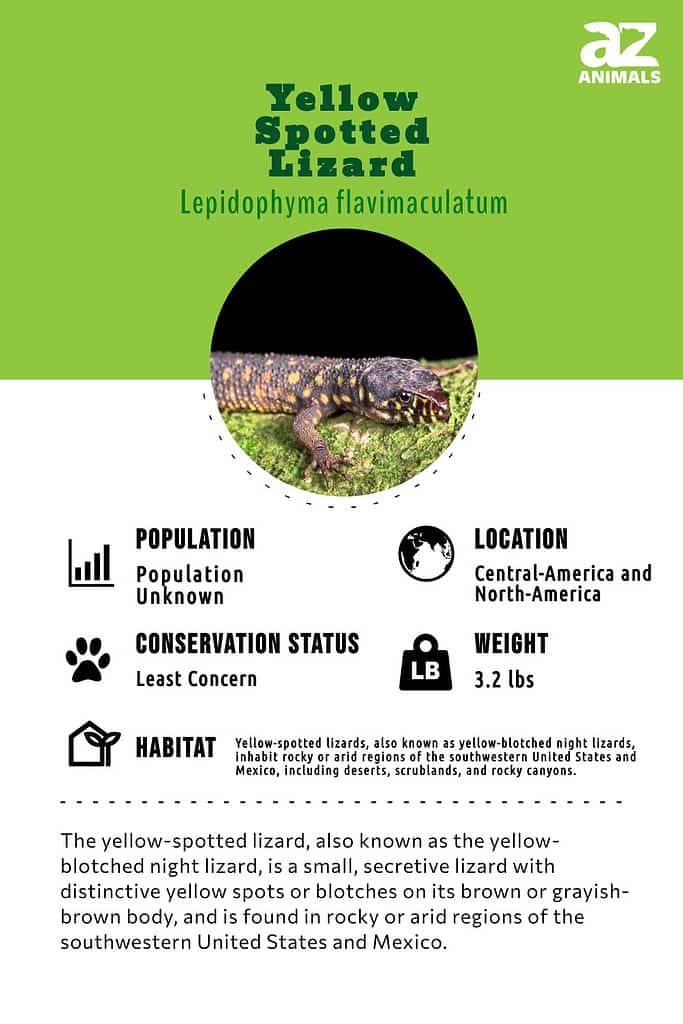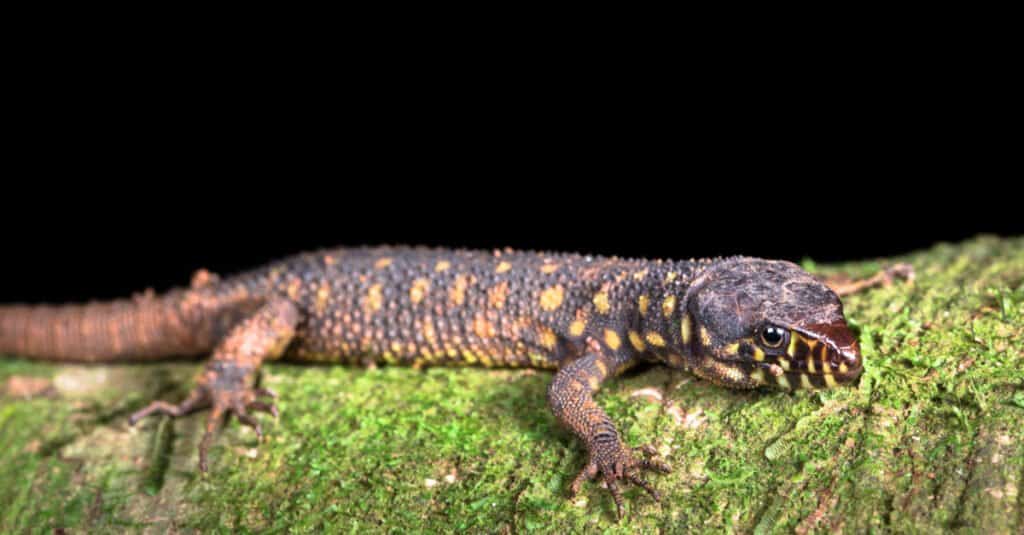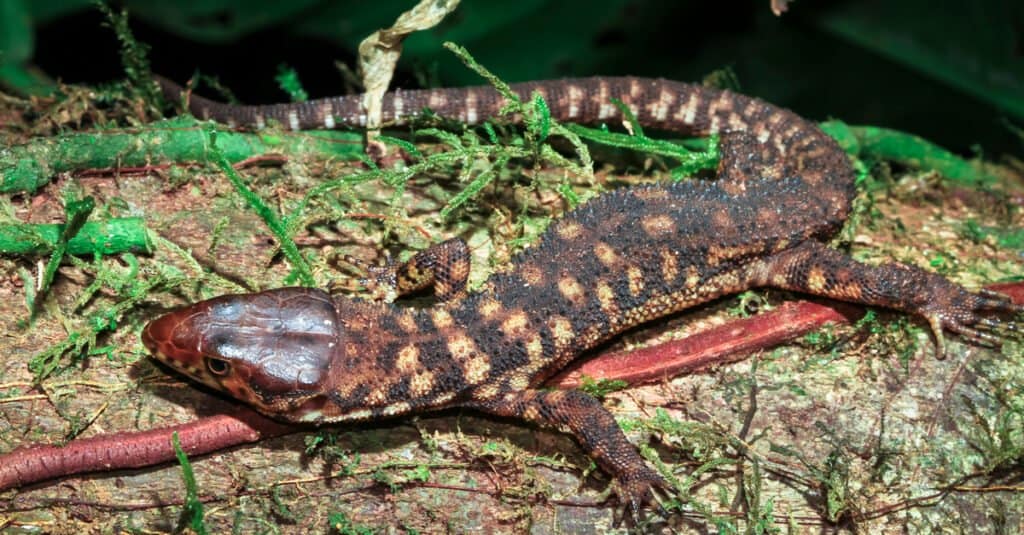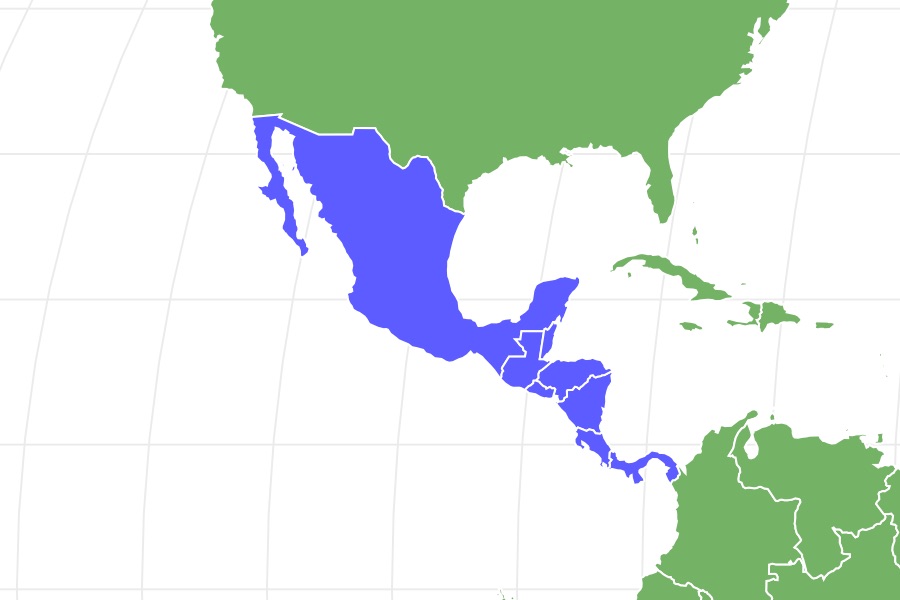Yellow Spotted Lizard
Lepidophyma flavimaculatum
Gives birth to live young.
Advertisement
Yellow Spotted Lizard Scientific Classification
- Kingdom
- Animalia
- Phylum
- Chordata
- Class
- Reptilia
- Order
- Squamata
- Family
- Xantusiidae
- Genus
- Lepidophyma
- Scientific Name
- Lepidophyma flavimaculatum
Read our Complete Guide to Classification of Animals.
Yellow Spotted Lizard Conservation Status
Yellow Spotted Lizard Facts
- Prey
- Insects
- Name Of Young
- Hatchlings, juvenile, or neonate.
- Group Behavior
- Solitary
- Fun Fact
- Gives birth to live young.
- Estimated Population Size
- Unknown
- Biggest Threat
- Loss of habitat
- Most Distinctive Feature
- yellow spots
- Other Name(s)
- Yellow-spotted tropical night lizard, yellow-spotted night lizard.
- Gestation Period
- 2.5 months
- Litter Size
- 5-8 hatchlings
- Habitat
- Rainforests, tropical dry forests, subtropical wet forests, and in water.
- Predators
- Birds, other lizards.
- Diet
- Carnivore
- Type
- Reptile
- Common Name
- Yellow spotted night lizard
- Number Of Species
- 1
- Location
- Central America, South America, Mexico
View all of the Yellow Spotted Lizard images!

The yellow-spotted lizard has seemingly gained popularity through the book Holes, but there’s a lot of misinformation about them as a result.
These nocturnal lizards prefer a warm and humid environment, primarily remaining in the same region for their entire life. They primarily eat insects, and they give birth to live young. With a lifespan of up to 15 years, these creatures prefer to remain solitary.
5 Incredible Yellow Spotted Lizards Facts!

Yellow-spotted lizard (Lepidophyma flavimaculatum) sitting in a tree, near Puerto Viejo de Sarapiqui, Costa Rica.
©Kevin Wells Photography/Shutterstock.com
- Some of the telltale identification features include the black body with yellow spots. Contrary to the tale told in the book Holes, there is no specific number of spots on the body.
- The yellow-spotted lizard is incredibly elusive, so it is hard for scientists to study them.
- Their tongue is milky white, and it is the main source of their venom, which is one of the most toxic substances in the natural world.
- The bite of a yellow spotted lizard can cause intense pain or death without treatment from an antivenom.
- When the lizard is still a baby, it is just 3cm long.
Scientific Name
The yellow-spotted lizard, or the yellow-spotted night lizard, has the scientific name Lepidophyma flavimaculatum. It is one of three subspecies of yellow lizards. It is a part of the Xantusiidae family of the Reptilia class.
Their scientific name is Latin in origin.
There are several other species in the Xantusiidae family, including:
- Xantusia arizonae – Arizona night lizard
- Xantusia bezyi – Bezy’s night lizard
- Xantusia bolsonae – Bolson night lizard
- Xantusia borealis – Great Basin night lizard
- Xantusia brachyura – Short-tailed night lizard
- Xantusia colliei – Collie’s night lizard
- Xantusia dageti – Dugeès night lizard
- Xantusia gracilis – Slender night lizard
- Xantusia gilberti – Gilbert’s night lizard
- Xantusia henshawi – Granite night lizard
- Xantusia jaycolei – Jaycole’s night lizard
- Xantusia riversiana – Rivers’ night lizard
- Xantusia sanchezi – Baja California night lizard
- Xantusia sierrae – Sierra night lizard
- Xantusia spinosa – Spiny night lizard
- Xantusia stacki – Stack’s night lizard
- Xantusia sutepensis – Sutep night lizard
- Xantusia taylori – Taylor’s night lizard
- Xantusia vigilis – Desert night lizard
- Xantusia wigginsi – Wiggins’ night lizard
Appearance
The yellow spotted lizard is quite beautiful, featuring the yellow dots that get its name. Apart from the spots, the colors of the rest of their body are mostly black, though they have thin, faint bands of yellow along their tail and rear flanks.
Unlike other lizards that have rough scales or skin over their entire body, the texture of this species varies, which is why proper identification is necessary. The head is smooth and shaped just like a snake’s head, and the teeth of this creature are black.
On average, this lizard measures a full length of 2.5 to 5 inches long. They weigh about 3 lbs. when they reach adulthood.

©Kevin Wells Photography/Shutterstock.com
Behavior
This lizard is known for its reclusive behavior, which has made it difficult for scientists to study them. Since they are nocturnal and solitary creatures, they mostly go out at night within their natural habitat to find prey. They aren’t typically found in groups, and they are territorial. Even though it is rather difficult to come across a yellow spotted lizard in the wild, they are venomous and can be incredibly dangerous if they bite you.
Evolution and Origins
The yellow-spotted night lizard (Lepidophyma flavimaculatum), sometimes known as the yellow-spotted tropical night lizard, is a type of night lizard. It is dispersed south to Panama from central Mexico across Central America. Lepidophyma flavimaculatum flavimaculatum has four subspecies.
The black body of the yellow-spotted lizard is covered in yellow patches all over. While their entire body is covered in tough scales, their head is sleek and silky, much like a snake. They only reach a maximum length of 4 inches. Thin yellow bands contrast with the black scales on their tail.
The burrows that the yellow-spotted lizards prefer to reside in provide shade from the sun and safety from rapacious birds. In a single hole, up to twenty lizards may reside. They may leap out of extremely deep tunnels to attack their prey because they have strong, powerful legs.
Habitat
The yellow-spotted lizard lives a nocturnal life in tropical wet forest environments in Central America and Mexico. Most often, they live in the rainforests, primarily at 2,265 feet altitude or higher. They’ll mostly crawl along the ground, but they also go in tree trunks or under the bark to find shelter.
Part of the reason that the yellow spotted lizard is so unique is that they form microhabitats. Once they decide where they want to live, they don’t venture far for the rest of their life. They stay close to home, even when it comes to hunting. These microhabitats make it difficult to determine the full population of the lizards.
Diet
The typical diet of a yellow spotted lizard is insectivorous, making them a carnivore. Lizards that live near water will push themselves up through the surface with the force of propelling their tail. However, more often than not, they don’t like to venture out to get their prey.
Predators and Threats
The yellow-spotted lizard doesn’t have many predators because little is known about the predators that go after it. Their microhabitats tend to protect them from unpredictable predators.
What Eats Yellow Spotted Lizards
Due to how small the yellow-spotted lizard is, it is on the menu for a few notable predators, including other reptiles. Snakes and even large centipedes will go after these lizards, but researchers know very little about any other potential predators.
What Do Yellow Spotted Lizards Eat?
Though this lizard is a carnivore, the majority of its diet consists of insects. Some of the most common insects that they eat include termites, ants, crickets, scorpions, spiders, millipedes, centipedes, water grubs, and mosquitos.
Reproduction and Life Cycle
Reproduction is rather unique for the yellow-spotted lizard because it can produce offspring parthenogenetically, which is a type of asexual reproduction. One of the fun facts about this lizard is that sperm is not necessary to fertilize the eggs, allowing the embryo to form independently. If the eggs are not fertilized before they become embryos, the offspring will only be female.
To have male yellow-spotted lizards, the eggs must be fertilized. These viviparous creatures give birth to live young, which is rather unique for lizards. Most reptiles lay eggs, but the female yellow-spotted lizard’s embryos grow within their body. When they are born, the litter is usually 5-8 babies. These reptiles tend to give birth in June or July.
The offspring of a yellow spotted lizard is called a juvenile, neonate, or hatchling. They are only about 3 cm long when they are born, but they mostly look like the parent(s) otherwise.
In the wild, this lizard can live to be about 11 years old, though they are not fully mature until age 3.
Population
Since this lizard is rather shy and elusive, it is rare that they are kept as pets. In fact, the reason that many people believe that it is endangered is that they are seldom seen in the wild, even in its preferred environment. However, the IUCN considers them to be Least Concern on their Red List.
View all 32 animals that start with YYellow Spotted Lizard FAQs (Frequently Asked Questions)
Are yellow spotted lizards carnivores, herbivores, or omnivores?
These lizards are carnivores, though their diet primarily consists of insects. They don’t really go outside of their natural habitat to hunt, so they must be able to find these insects where they make their home.
Are yellow-spotted lizards poisonous or venomous?
This lizard is incredibly venomous, but the bite is treatable. If you experience such a bite, they’ll do a lot of damage with their serrated teeth. The venom is even on their tongue, so they don’t even need to bite to release it.
How many yellow-spotted lizards are there in the world?
It is a rare sight to see a yellow spotted lizard in the wild. While their total population in the world is unknown, scientists find them to be of least concern, and no conservation efforts are being made to protect the species or their environment.
Are yellow-spotted lizards real?
Yes. While the idea of the yellow spotted lizard was popularized by the book Holes (and the movie of the same name), they are hardly the same as the fictitious species.
What is a yellow-spotted lizard?
The yellow-spotted lizard, which is better known as the yellow-spotted night lizard, is a reptile that lives in the same spot for the entirety of its 11-year lifespan. They can reproduce asexually, and their main colors are black with yellow spots along their entire body. They are nocturnal, hunting at night for their next meal. Identification of this reptile is rather easy because of the distinct colors.
What does a yellow-spotted lizard look like?
The yellow-spotted lizard has a black body with yellow spots all over. While their body has rough scales all over, their head is smooth and sleek like a snake. They only grow to be about 4 inches long. Their tail is covered by thin bands of yellow against the black scales.
How many spots does a yellow-spotted lizard have?
Though the book Holes states that these lizards specifically have 11 spots, that is not true. Their number of spots is determined by their size.
Where does the yellow-spotted lizard live?
This lizard is native to South and Central America.
Thank you for reading! Have some feedback for us? Contact the AZ Animals editorial team.
Sources
- Learn About Nature / Accessed February 21, 2022
- eHow / Accessed February 21, 2022
- Pets On Mom / Accessed February 21, 2022
- Kidadl / Accessed February 21, 2022
- FactInformer / Accessed February 21, 2022


















